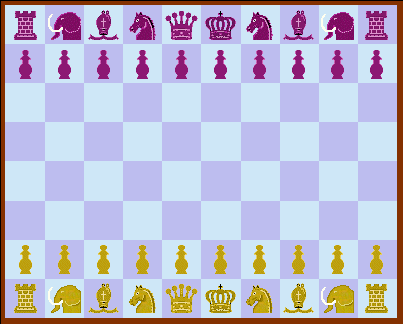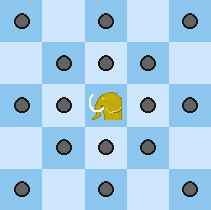

Introduction
The initial setup holds standard pieces plus two Mastodons per side. The pawns move as in orthodox chess, inclusive of the initial double-step and en passant. Castling exists, but the King jumps three squares instead of two. As usual, the Rook ends up beside the King. Promotion rules are the same as in orthodox chess (with the addition of the Mastodon). Otherwise normal chess rules apply except for the following. By the term 'piece' I mean all pieces, including pawns. Any pawn situated on the same file as a friendly piece, with zero or more empty squares in between, can leap forwards over the latter and land on an enemy piece standing on the same file, provided that there is just one friendly piece in between. The pawn can land on all enemy pieces on the file, but not on empty squares. However, enemy pieces positioned behind an enemy pawn (or yet another friendly piece) cannot be reached, although the enemy pawn, in itself, can be captured. When the pawn lands it behaves like a cannon shell and "explodes", that is, it is removed together with the enemy piece.
This pawn movement functions similarly as a cannon. It opens up interesting tactical and strategical possibilities during all phases of the game. One such possibilty is to exchange a pawn on the same file in order to open the file for continued attack. Pawns that fulfil the requirements for making a jump are referred to as "cannons". The cannon move seems to quicken the pace of the game, something which could be desirable in big board variants.
Weakening the f-file in the opening by moving the pawn two steps could be dangerous, while it compromises the King's position. Despite the obvious tactical dangers, the positional qualities of the game are retained. But the risk of draw is probably lessened since opening of files for attack is facilitated.
One could argue that the value of the pawn is higher in Gunnery Chess (8x10) than in regular chess. However, the cannon capability belongs equally much to the other pieces, because it is a cooperative move. In the images below, which piece generates the cannon move? Is it the knight or the pawn behind it? As the cannon move increases the power of all pieces, I believe that the relative value of the pieces is retained.
The cannon move is less brutal than one would expect. This is because the leaping pawn also annihilates itself. In practical endgames one could put the king in front of a pawn, and let the pawn leap over the board to capture an enemy pawn. But the result is only that both pawns are removed. Such maneuvers cost time, and the gain could be nil. This fact, and the fact that pawns can protect friendly pieces from cannon attacks, assures that the positional soundness of the game is retained. The introduction of the cannon move does not degrade the game to a tactical turmoil, but it clearly enhances the tactical nature of the game. According to the dictionary the term gunnery refers to the use of guns; esp: the science of the flight of projectiles and of the effective use of guns.
The Mastodon jumps one or two steps diagonally or orthogonally. It has roughly the same value as Rook + Pawn. The Mastodon jump complements the jump move of the Knight. A Mastodon, together with a King, can give mate to a lonely King. Rook and Mastodon cooperate effectively in the attack on the enemy king. It is a piece which is easily mastered, very suited for the congested environment in a game with many pieces and pawns. It is very suited for cooperating with the cannon pawn.
 The Mastodon jumps one
or two steps diagonally
or orthogonally.
The Mastodon jumps one
or two steps diagonally
or orthogonally.
Examples

In this position white's cannon pawn can reach the black knight and the black pawn, but not the bishop (and not the empty square before the black knight).

Here white's pawn can reach and "explode" any of the three black pieces.

Here white's pawn cannot reach any of the black pieces.
For more examples, see Gunnery Chess (8x8).
• You can download my free Gunnery Chess (8x10) program here, but you must own the software Zillions of Games to be able to run it.
• Try playing Gunnery Chess (8x10) per e-mail, against a human opponent, here.
• Don't miss my other chess variants.
© M. Winther 2006